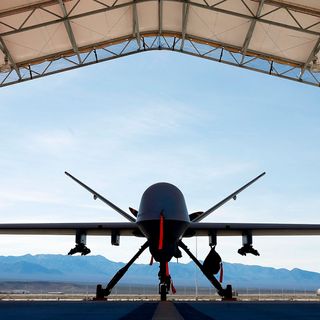In Hugh White’s latest Quarterly Essay, he argues that “America will lose, and China will win” in Asia. China’s power has continued to grow stronger “economically, militarily and diplomatically” and America’s resolve has “weakened”. But while the US’s military superiority in the region is under strain, America is undertaking a significant technological modernisation program of its own.
Begun under the Obama administration but continuing under Donald Trump, the Pentagon has begun an “offset” strategy — the third in its history — that aims to find new technologies, military capabilities and institutions that will allow the US to “leap ahead” of its competitors.
Mapping the Third Offset: Australia, the United States and future war in the Indo-Pacific

And so a new type of great power struggle is beginning to take shape across the Indo-Pacific between China and the US. At its heart is the fact the US’s edge in military technology, part of its strategic power since the first Gulf war, is no longer as assured.
The technologies supporting advanced missiles, satellites, submarines and other types of military capabilities have proliferated. China has invested heavily in these systems while the US focused on war in Iraq and Afghanistan.
Beijing has turned them into an advantage. Instead of using these capabilities to project force as the US has done, China is using them to raise the military cost and risk for Washington if it chooses to intervene in a conflict close to its border.
This could lead allies and partners to question America’s ability to deliver on alliance guarantees and other commitments without escalating to the use of a nuclear weapon in a crisis, in turn affecting Washington’s credibility.
Major competition over emerging technologies is taking place between the US and China, and the centre of gravity may be beginning to shift from Silicon Valley to Shenzhen
Further, major competition over emerging technologies is taking place between the US and China, and the centre of gravity may be beginning to shift from Silicon Valley to Shenzhen.
Funding and technological innovation has shifted from government labs to the private sector. Much of this private sector technology, such as artificial intelligence, will be the basis of future warfare. China has responded by reforming its military, shrinking its size and increasing its agility. Beijing also has recognised that new technologies will fuel its next stage of economic development, recently announcing new national plans in quantum computing, artificial intelligence and robotics.
Much of this technology can be used in military and civilian applications, blurring the roles of the state and the private sector. Foreign investment in new technology start-ups and a global battle over human talent are becoming defining features of the competition.
Last, US dominance is increasingly costly. Sustaining America’s military and strategic position with its present capabilities is straining the Pentagon’s fiscal resources.
A variety of priorities such as nuclear modernisation, new army procurement programs, the F-35 and a larger navy are vying for pieces of a stagnating budget. Even with Trump’s proclamations that the US defence budget is growing, a broader deal is needed in congress for it to occur.
Funding and technological innovation has shifted from government labs to the private sector. Much of this private sector technology, such as artificial intelligence, will be the basis of future warfare.
Recognising these trends, the Pentagon launched the third offset strategy in 2014: essentially a department-wide effort to develop new technologies, institutions and culture to move ahead of its competitors.
The third offset is a set of three related strategies. The first involves betting on technologies such as hypersonic weapons (those that travel faster than Mach 5) that will provide ways to project power in hostile environments.
Second, it aims to develop new types of military technologies and capabilities that will be economically sustainable. New cheap robotics or high-energy lasers that are powered by a vessel’s power supply may allow the US to maintain its strategic position by doing more with less.
The third is that by reforming America’s defence institutions and developing new ones, the Pentagon will be able to take advantage of private sector developments faster and better than its rivals over the long term. One such example is the Defence Innovation Unit Experimental (DIUx). DIUx aims to bring the Pentagon to Silicon Valley, making it easier and faster for start-ups to bid on procurement projects from Defence, as well as providing another source of funding for emerging technology companies.
But the US defence budget remains an uncertainty — many of these capabilities will require a boost in funds now to enter production. China also is reforming its bureaucracy to take advantage of innovation and is investing billions in new national technology industries. Beijing is undertaking its own offset.
Canberra can do more to encourage collaboration and co-ordinate our own defence research efforts with the US.
Despite Australia’s attention to defence research and development in last year’s defence white paper and the creation of bodies such as the Next Generation Technology Fund, new defence innovation models similar to some of those being pioneered in the US are still absent here. Whether Australia needs its own DIUx or more innovative joint-operated and funded organisations with other allies and partners is becoming a more pressing question. Equally, Australia should be maximising its participation in exercises and simulations as these technologies are brought together into military concepts.
A failure to find new ways for American forward-deployed forces to fight more effectively and sustainably in the Indo-Pacific may damage US credibility with allies and partners in the region. The direction of the third offset, and the shape of this emerging arm wrestle over strategic technologies, should be a significant factor in Australia’s strategic outlook.






